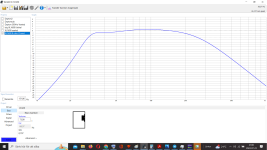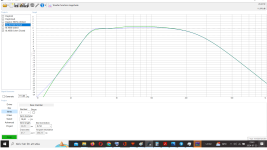Have 4 big Faithal 18XL1600 that I buy 5 years ago that i never uses,
They was/are mounted in 4 big PA-boxes, but im thinking if I can build some "nicer" cabinettes for them and also a "potent" MTM or a MM/TM.
Maby use two 18XL1600 per side?
They are 8 ohm drivers!
My biggest "worry" is that I think they will need BIG boxes to "work good".
So I ask you guy´s, how many liters does it need "as a minimum", to play desent?
regards John
They was/are mounted in 4 big PA-boxes, but im thinking if I can build some "nicer" cabinettes for them and also a "potent" MTM or a MM/TM.
Maby use two 18XL1600 per side?
They are 8 ohm drivers!
My biggest "worry" is that I think they will need BIG boxes to "work good".
So I ask you guy´s, how many liters does it need "as a minimum", to play desent?
regards John
Attachments
Sealed box Qtc = 0.7 is about net 75 l, then add EQ to taste if you want.
Or Qtc = 0.8 in ~55 l, that's about 45x45x27 cm internally. But the higher the Qtc the more EQ boost it needs to lift the low-end (if the room-gain don't helps enough).
Or Qtc = 0.8 in ~55 l, that's about 45x45x27 cm internally. But the higher the Qtc the more EQ boost it needs to lift the low-end (if the room-gain don't helps enough).
Last edited:
Yes, I get that way way small sealed enclosure at 74 liters worth of size, but the tradeoff is a poor bass performance of a MINUS 3.04 decibels at a "barely bass" frequency of 62.65 hertz.
Considering the EBP value, this driver should be used in a large (145-300 L) ported enclosure...for some real bottom end performance. Considering how far the response past the sixty or so hertz is falling, no amount of "EQ" can save it.
-------------------------------------------------------------------------------------------------------------------------------------------------------------Rick...
Considering the EBP value, this driver should be used in a large (145-300 L) ported enclosure...for some real bottom end performance. Considering how far the response past the sixty or so hertz is falling, no amount of "EQ" can save it.
-------------------------------------------------------------------------------------------------------------------------------------------------------------Rick...
73 liter netto is Q 0,707, this with EQ 12 dB at 30 hz LP 250 hzSealed box Qtc = 0.7 is about net 75 l, then add EQ to taste if you want.
Can this woofer play up to 250 hz ?
Attachments
Yes that 145-300 liter was my "worry".es, I get that way way small sealed enclosure at 74 liters worth of size, but the tradeoff is a poor bass performance of a MINUS 3.04 decibels at a "barely bass" frequency of 62.65 hertz.
Considering the EBP value, this driver should be used in a large (145-300 L) ported enclosure...for some real bottom end performance. Considering how far the response past the sixty or so hertz is falling, no amount of "EQ" can save it.
They are in ca 130 liter ported today, and needs lots of power.
Never tought about EBP value before, i don´t "understand" this 86 hz value?
I think it can, the first 'wrinkle' in its free-air impedance response seems about 350Hz and the natural frequency response start to drops about 300Hz, below that is smooth.Can this woofer play up to 250 hz ?
EBP:Never tought about EBP value before, i don´t "understand" this 86 hz value?
''Il est utilisé pour définir de façon rapide quel type de caisse sera la plus approprié pour un haut-parleur donné. Ce paramètre est calculé en divisant Fs par Qes. Un résultat proche de 100 est bien pour une caisse à évent alors qu’un résultat proche de 50 est mieux pour une caisse close. Quand EBP est entre 50 et 100 le haut-parleur peut être utilisé en clos ou en bass-reflex. Ce paramètre EBP est juste une petite règle « repère » pour choisir une caisse quand le fabricant du haut-parleur ne donne pas de recommandations particulières.''
https://en.toutlehautparleur.com/parametres-thiele-and-small/
Woofer plays sideways, to get a narrower front baffle!55 l, that's about 45x45x27 cm internally
50 x 50 x 32 cm internally is 80 liter, and driver take 7,3 liter so 72,7 left.
Or 56 x 45 x 32 = 80 liter
Two on top of eachother is 90 cm (45 x 45 cm), and maby 50 cm high MTM can work with tweeter at hight 115 cm cc?
18XL1600 works very well in a bass reflex cabinet of 80 liters tuned at 27 Hz.
Pretty much tracks my target curve for 30 m2 rooms.
Room gain takes care of lowest bass down to 20 Hz.
That bass will be brutal 🙂

Pretty much tracks my target curve for 30 m2 rooms.
Room gain takes care of lowest bass down to 20 Hz.
That bass will be brutal 🙂
115cm is
115cm tweeter height may works but it depends. Another good option is to mount the drivers to opposite walls in a common enclosure to cancel out/reduce box vibration and reduce 2nd harmonic distortion, plus you have more freedom to set the tweeter height.Two on top of eachother is 90 cm (45 x 45 cm), and maby 50 cm high MTM can work with tweeter at hight 115 cm cc?
Real close results 80 liter sealed or vented.18XL1600 works very well in a bass reflex cabinet of 80 liters tuned at 27 Hz
Sealed need 4 dB more EQ at 30hz ( for the same result)
Port 4" ...34,5 cm long, how many liters take that port away?
Attachments
EBP:
''It is used to quickly define which type of cabinet will be most appropriate for a given loudspeaker. This parameter is calculated by dividing Fs by Qes. A result close to 100 is good for a vent box while a result close to 50 is better for a closed box. When EBP is between 50 and 100 the loudspeaker can be used enclosed or in bass reflex. This EBP parameter is just a small “benchmark” rule for choosing a cabinet when the loudspeaker manufacturer does not give specific recommendations.''
English please, in this case an English translation of what the French language website.
dave

diyAudio moderation team
Sorry, I wasn't sure about the translation and just quoting.English please, in this case an English translation of what the French language website.
dave
diyAudio moderation team
Generally, you would get more output with a larger enclosure. The trade-off is up to you. How much output do you need and what is an acceptable low frequency cut-off? Do you need both high output and low frequency extension at the same time?
HiGenerally, you would get more output with a larger enclosure. The trade-off is up to you. How much output do you need and what is an acceptable low frequency cut-off? Do you need both high output and low frequency extension at the same time?
I wont "most of it" ( without crossing the line of "to much" compromise)
I am a really high level listener and the room/space is about 500 kubicmeter.
Low 30-ish is appreciable
@jawen
If you want me to I can make a room gain simulation for you.
I need listening posision in relation to side and rear walls as well as ear hight over floor.
I need drivers position in relation to rear and closest side wal as well as distance to floor.
See example.
I use the simulated result to interpolate a target curve that will be used to get as close as possible to a flat frequency response in the listening room.
See this example...

If you want me to I can make a room gain simulation for you.
I need listening posision in relation to side and rear walls as well as ear hight over floor.
I need drivers position in relation to rear and closest side wal as well as distance to floor.
See example.
I use the simulated result to interpolate a target curve that will be used to get as close as possible to a flat frequency response in the listening room.
See this example...
At what power? At peak power a classic prosound Vb = Vas/1.44 = 146.9 L with a Sd/3 = 404 cm^2 vent is ~59.3 cm long and still has an unacceptably high ~29 Hz/34ms vent mach, so ideally needs a (ML)TL or inverse tapered TQWT.18XL1600 works very well in a bass reflex cabinet of 80 liters tuned at 27 Hz.
That formula again. Please elaborate what's the secret of this ratio!Vb = Vas/1.44
Pg. 76: https://archive.org/details/HowToBuildSpeakerEnclosuresByAlexixBadmaieffDonDavis/page/n75/mode/2up
“A nagging question in the design stage of any enclosure of this type is "How large shall it be?” It was pointed out earlier that the enclosure can be too large or too small for proper bass-reflex action. This implies that an optimum volume exists and indeed it does. This optimum volume does not depend upon the size of the speaker nor its resonant frequency per se but rather on the ratio of enclosure air stiffness to the speaker cone suspension stiffness. This optimum ratio is 1.44 or, looking at it another way, the speaker resonant frequency in the enclosure before porting should be 1.56 times the free-air resonance of the speaker. This size enclosure, when properly tuned, yields at the same time the most extended low-frequency response and a transient response with subjectively unnoticeable hangover, assuming sufficient damping exists. Compared to the entirely closed cabinet, the half-power point (3 db down) occurs at 0.7 times the closed cabinet speaker resonance for an extension of one-half octave."
“A nagging question in the design stage of any enclosure of this type is "How large shall it be?” It was pointed out earlier that the enclosure can be too large or too small for proper bass-reflex action. This implies that an optimum volume exists and indeed it does. This optimum volume does not depend upon the size of the speaker nor its resonant frequency per se but rather on the ratio of enclosure air stiffness to the speaker cone suspension stiffness. This optimum ratio is 1.44 or, looking at it another way, the speaker resonant frequency in the enclosure before porting should be 1.56 times the free-air resonance of the speaker. This size enclosure, when properly tuned, yields at the same time the most extended low-frequency response and a transient response with subjectively unnoticeable hangover, assuming sufficient damping exists. Compared to the entirely closed cabinet, the half-power point (3 db down) occurs at 0.7 times the closed cabinet speaker resonance for an extension of one-half octave."
- Home
- Loudspeakers
- Multi-Way
- How small box can an Faital Pro 18XL1600 work good in?


